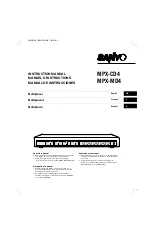
(upper) readout. The term
REL
will appear at the upper
left of the LCD to indicate operation in this special mode.
In
REL
mode, the primary (lower) readout shows the
difference
between ongoing measurements and the
frozen value.
REL
mode is useful for tracking changes in
dynamic processes or deviations from baseline readings.
When the
REL
⌬
button is pressed, the meter
automatically exits Auto Ranging mode and enters
Manual Ranging mode using the full-scale range in effect
at that moment.
To exit
REL
mode, press the
REL
⌬
button again.
Disabling Auto Power Off (APO)
By default, the meter automatically powers itself off if
no front-panel button is pressed within any span of
15 minutes. Fifteen seconds before the end of this
15-minute period, the meter announces that the APO
function is about to engage by sounding a sequence of
3 double beeps, followed by a long beep.
Once the APO function has activated and powered the
meter off, you can “wake the meter up” simply by turning
the rotary function switch to a different position.
The
icon on the left side of the LCD indicates that the
APO function is enabled. To disable the APO function, you
must power on the meter in a special way—by pressing
and holding the
REL
⌬
button while turning the rotary
function switch to any position other than
OFF
. If the
meter is powered on in this way, the
icon will not
appear. If the meter is left unattended with APO disabled,
it will remain powered on until its battery discharges
(typically, several days later).
Using the Analog Bar Graph
The bar graph at the bottom of the LCD (see below)
provides an analog representation of every measurement
shown in digital form on the primary readout above it.
The key feature of the bar graph is its fast response time.
It can reflect a change in a measured value 10 times
more quickly than the digital readout can. Accordingly, it
is useful for tracking parameters that change very rapidly
(a voltage or current, for example).
11
DMM550_Manual_RR1_FINAL_070914_awb 7/9/14 1:55 PM Page 11










































